The first thing you need to play the Pokemon Trading Card Game is a coin, a poison marker, and a set of damage counters. You also need to construct a 60-card deck. This deck has to include at least one basic Pokemon, energy cards, trainer cards, and stage one and two Pokemon. A good deck would have around 25 Pokemon, 25 energy cards, and 10 trainer cards. Also, you can't have more than 4 of any one card or Pokemon, excluding basic energy cards. This only applies to cards with the exact same name, so you could still use 4 Pikachu, 4 Surfing Pikachu, 4 Flying Pikachu, and 4 Lt. Surge's Pikachu all in the same deck. You also have to find a friend who also has all the listed things.
Setup - Arena
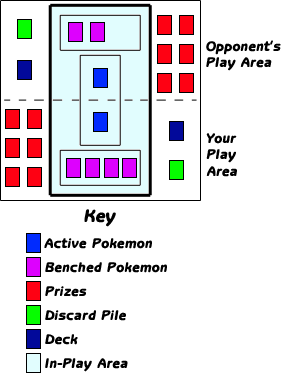
Starting the Game
First, you and your opponent must shuffle your decks.
Draw a hand of 7 cards. You and your opponent must each choose
a basic Pokemon for an active Pokemon and place it face down in
the arena. You may each choose up to 5 basic Pokemon to put face
down on the bench. If you don't have any basic Pokemon in your
hand, show your hand to your opponent, shuffle your hand into
your deck, and draw 7 cards. When you do this, your opponent can
choose to draw up to 2 cards. You and your opponent each draw
six cards and, without looking at them, place them face down as
prizes. Flip a coin to decide who goes first. Flip over all the
active and benched Pokemon in the arena.
During a Turn
1) Draw a card.
2) Now you can do any of these things in whatever order you want:
- Put a basic Pokemon on your bench
- Evolve a Pokemon
- Attach an energy card to a Pokemon (only once per turn)
- Play a trainer card
- Retreat your active Pokemon
- Use a Pokemon Power
3) Attack with your acitve Pokemon - in order to attack, you must
meet energy requirements. Your opponent puts damage counters on
his or her Pokemon after applying weakness or resistance. If you
have knocked out your opponent's Pokemon, then take a prize.
4) Your turn is over
Deciding the Winner
A player has won the game when he or she has drawn all of his
or her prizes. You also win if your opponent can't draw a card
at the beginning of their turn or if your opponent has no active
Pokemon.
Energy Cards
Energy cards are used to pay the cost of your Pokemon's attack
or retreat cost. The energy attached to your Pokemon must match
the type and quantity of your Pokemon's energy cost in order for
you to attack.
What to Do When a Pokemon is Knocked Out
When a Pokemon has damage equal to or greater than its hit points,
that Pokemon is knocked out and you must discard it and all cards
attached to it. You draw a prize when you knock out one of your
opponent's Pokemon and your opponent draws a prize when they knock
out one of your Pokemon.
Weakness & Resistance
When a Pokemon is attacked by a Pokemon whose type matches its
weakness, that Pokemon takes twice the damage that it would normally
receive. When a Pokemon is attacked by a Pokemon whose type matches
its resistance, that Pokemon takes 30 less damage than it would
normally receive.
Sleep, Confusion, Paralysis, and Poison
If your Pokemon is asleep, it can't attack or retreat. Turn your
Pokemon sideways to show it is alseep. Flip a coin after each
player's turn. On heads, your Pokemon awakens and on tails your
Pokemon remains asleep. If your Pokemon is confused, you must
flip a coin when you try to attack or retreat, after discarding
any necessary cards for attacking or retreating. If retreating,
on heads your Pokemon can retreat and on tails the retreat fails
and you cannot try retreating againg that turn. If attacking,
on heads your attack works normally and on tails your Pokemon
attacks itself doing 20 damage (apply weakness and resistance).
If your Pokemon is paralyzed, it can't attack or retreat. Turn
your Pokemon sideways to show that it is paralyzed. Your Pokemon
recovers after your turn ends. If your Pokemon is poisoned, place
a poison marker on it to show that it is poisoned. A poisoned
Pokemon takes 10 damage (not applying weakness or resistance)
after each player's turn. If a Pokemon is already asleep, confused,
or paralyzed, a new condition of sleep, confusion, or paralysis
takes place of the old one. A Pokemon can only be affected by
one of these three conditions at once. However, a Pokemon can
be poisoned and affected by another condition. Your Pokemon is
cured of these conditions if it is evolved.
Evolution
A Pokemon can be evolved after it has been in play for at least
one turn. That means you can't evolve a Pokemon you just put into
play or just evolved that turn. When you evolve a Pokemon, the
Pokemon's name must match the name next to the evolution stage
of its evolved form. This means that a Dark Charizard can only
evolve from Dark Charmeleon, it can't evolve from Charmeleon or
Blaine's Charmeleon. This also means that Raichu can't evolve
from Surfing Pikachu or Flying Pikachu.
Glossary
- Active Pokemon - Your Pokemon that is in front of all your other
Pokemon. Only your active Pokemon can attack.
- Attach - When you take a card from your hand and put it on one
of your Pokemon in play.
- Attack - When your active Pokemon fights your opponent's defending
Pokemon or the text written on a Pokemon card that shows what
happens when it attacks.
- Basic Energy Card - A grass, fire, water, lightning, psychic,
or fighting energy card.
- Basic Pokemon Card - A card that you can play directly from
your hand to put a Pokemon into play.
- Bench - Where your Pokemon go that are in play but aren't actively
attacking. They can become active Pokemon if your active Pokemon
retreats or is knocked out.
- Damage Counter - One damage counter is placed on a Pokemon for
every 10 damage it has. Damage counters remain on a Pokemon even
if it is evolved or benched.
- Defending Pokemon - The Pokemon that is being attacked.
- Discard Pile - The cards that you have discarded. These cards
remain face up and can be viewed by anyone at any time.
- Energy Card - The type of card that powers your Pokemon's attacks.
- Evolution Card - A card that you play on top of another card
to evolve a Pokemon. This card cannot be placed directly on the
bench or directly played as an active Pokemon.
- Hit Points - A number telling you how much damage a Pokemon
can take before it is knocked out.
- Knocked Out - A Pokemon is knocked out when it has damage equal
to or greater than its hit points. That Pokemon and all cards
attached to it are placed in the discard pile.
- Prizes - Each player starts with six prizes, face down. A prize
is drawn whenever a player knocks out one of their opponent's
Pokemon. Whoever draws all six of their prizes first is the winner.
- Resistance - When a Pokemon is attacked by a Pokemon whose type
matches its resistance, that Pokemon takes 30 less damage than
it would normally receive. Resistance is indicated at the lower
middle of a Pokemon card.
- Retreat - When you switch your active Pokemon with one of your
benched Pokemon. You must discard energy cards that are attached
to your retreating Pokemon equal to your Pokemon's retreat cost.
Retreat cost is indicated at the lower right corner of a Pokemon
card.
- Stadium Card - A trainer card that says stadium card on it.
It stays in play and is only discarded if another stadium card
is put into play.
- Trainer Card - A card that says Trainer on the top of it. Trainers
can be played at any time during your turn. Follow the instuctions
given on the trainer card you play.
- Weakness - When a Pokemon is attacked by a Pokemon whose type
matches its weakness, that Pokemon takes twice the damage that
it would normally receive. Weakness is indicated at the lower
left corner of a Pokemon card.
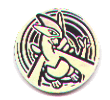 Coin |
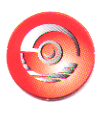 Generic Marker |
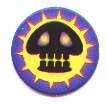 Poison Marker |
 Damage Counter |
 Baby Pokemon |
 Energy Card |
 Trainer Card |
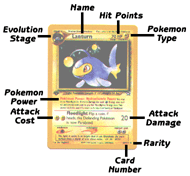 |